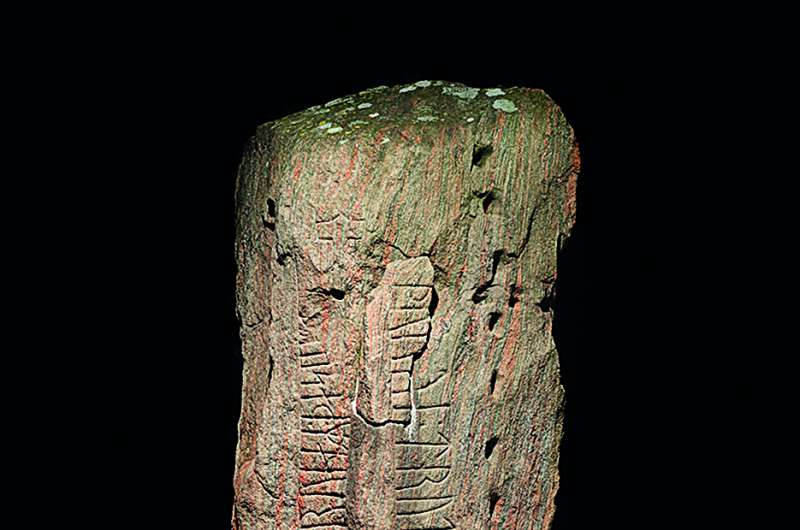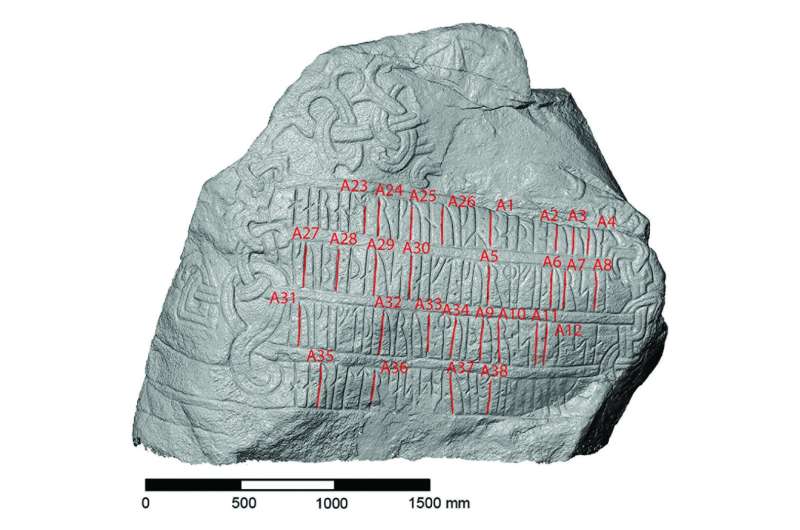This article has been reviewed according to Science X's editorial process and policies. Editors have highlighted the following attributes while ensuring the content's credibility:
fact-checked
peer-reviewed publication
proofread
Runestones reveal the power of a Viking queen

Archaeologists have used 3D scanning to investigate inscriptions carved on two groups of Danish runestones, revealing that four stones were likely made in dedication to a powerful Viking Queen.
The first group, the Jelling Stones, were raised by Harald Bluetooth, the king who is credited with founding the Danish state, in commemoration of his parents Gorm and Thyra. The second group, the Ravnunge-Tue Stones, also mention a woman called Thyra.
The team theorized that these two groups of stones referred to the same person. If correct, then Thyra would be the most-mentioned person on Viking-Age Danish runestones.
"We wanted to see if we could find the same rune carver on some of these stones, so that we could connect the Ravnunge-Tue stones with the Jelling stones," says lead author of the research, Dr. Lisbeth M. Imer from the National Museum of Denmark. "If there was a connection, it would be highly likely that all the stones referred to the same woman, Thyra, mother of Harald Bluetooth."
To test the validity of this theory, Dr. Imer and a team of investigators from several Scandinavian institutions made 3D models of the runestones and analyzed the shape and carving techniques used to cut the runes and the language used. Their results are published in the journal Antiquity.

The authors compared carved grooves of well-preserved runestones in order to identify the distinctive marks made by different carvers. Similarities between the runes of the Læborg Stone (one of the Ravnunge-Tue Stones) and the Jelling 2 Stone suggest that they were engraved by the same person.
Therefore, the references to Thyra on both groups of stones likely refer to the same person—the Danish Queen and mother of Harald Bluetooth. This indicates that she was a particularly powerful and celebrated individual. It is likely that she held land and authority in her own right, not only through her husband.
"No other Viking man or woman in Denmark has been mentioned on that many runestones," says Dr. Imer, "and it underlines her undeniable importance for the assembling of the realm under the rule of her son, Harald Bluetooth."
Importantly, this means that women likely had more influence in Viking-Age Denmark than previously believed. It indicates that Viking women may have been able to hold power in their own right and rule on behalf of their husbands or under-age sons.
It also has important implications for our knowledge on the formation of the Danish state.
"The combination of the present analyses and the geographical distribution of the runestones indicates that Thyra was one of the key figures—or even the key figure—for the assembling of the Danish realm," state the authors.
More information: Lisbeth M. Imer et al, A lady of leadership: 3D-scanning of runestones in search of Queen Thyra and the Jelling Dynasty, Antiquity (2023). DOI: 10.15184/aqy.2023.108
Journal information: Antiquity
Provided by Antiquity




















